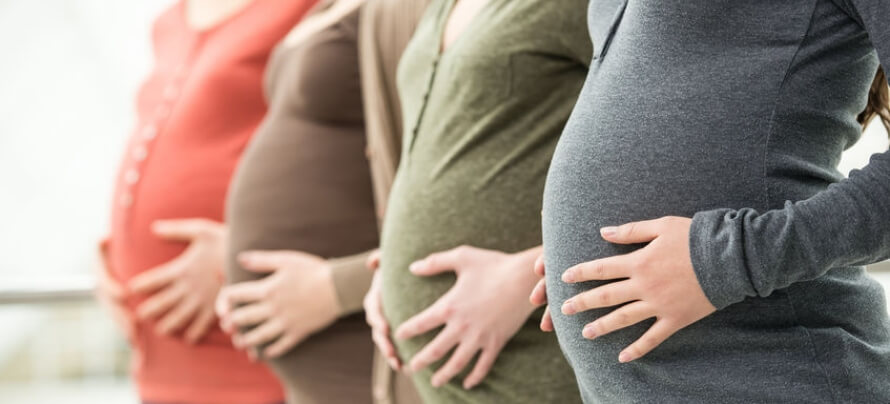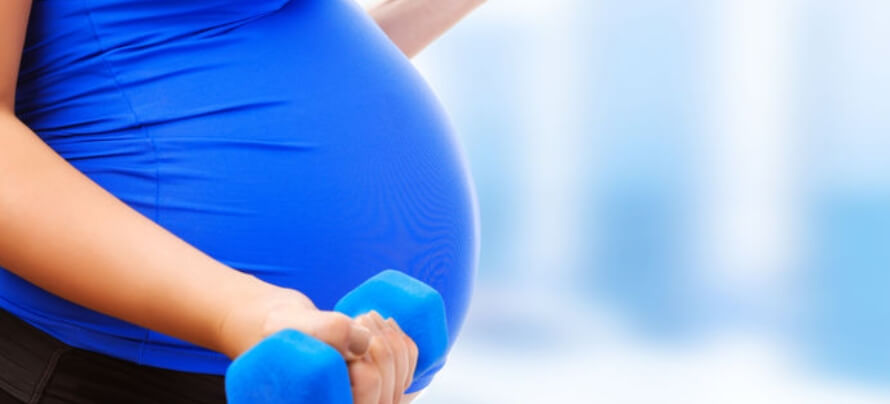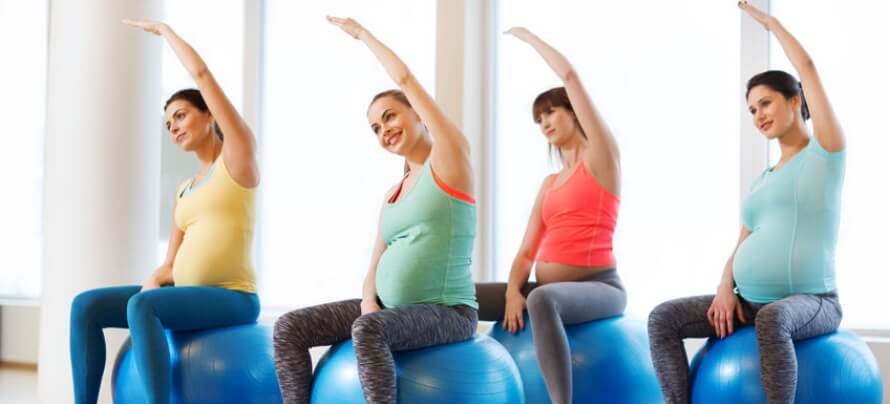Congratulations! You’re pregnant!
You’re about to start an amazing life-changing journey. But one thing that shouldn’t change is your fitness!
In fact, your exercise routine is more important now than ever.
An active, healthy pregnancy will help reduce stress, improve your baby’s health in utero and well into life, and dramatically speed up your post-delivery recovery.
But you need to look at your workouts a little differently now that you’re exercising for two, and that’s what we’re going to talk about in this article.
Specifically, we’re going to look at the adjustments you need to make to your exercise routine while your mini-me is growing so you can have a healthy and straightforward pregnancy, childbirth, and recovery.
We’re also going to talk about how to avoid common post-pregnancy problems like diastasis recti, leakage, prolapse, and more.
(Many women think their health and fitness has to fall apart after having kids, but they’re most definitely wrong!)
So, if you’re ready to have a happy, healthy pregnancy, let’s get started!
Think “Fit and Healthy” and Not “Lean and Ripped”
There’s nothing wrong with being lean and ripped.
But when you’re pregnant, it’s time to shelve the vanity and shift your focus to being fit and healthy, instead.
And yes, I’m talking about weight gain.
You see, there are good reasons that women gain weight during pregnancy.
Some of the extra pounds come from the weight of the baby, the placenta, the amniotic fluid and the expanded uterus, of course, but some of it is simply fat.
And that fat is important!
Think of it as an insurance policy for you and your baby should unexpected problems occur during pregnancy, not an unsightly layer of flab that needs to be dieted away.
[Read: How to Prevent Unhealthy Weight Gain During Pregnancy]
So, here’s what you’re really looking to achieve during your pregnancy:
Preserving Bone Density
Your body will make sure the baby gets what it needs, but what about you?
Growing a human being depletes your body of all sorts of vitamins and minerals, especially calcium, which can weaken your bones.
Resistance training will help prevent this from happening.
Preserving Muscle
Preserving your muscle during your pregnancy will make you feel good and give you the strength to carry baby comfortably, as well as help you recover after delivery.
Lean mass also helps you burn more calories, so the more muscle you have, the faster you’ll be able to get back to your pre-pregnancy weight.
Raising Your Heart Rate
As you increase your heart rate during exercise, your baby’s heart rate will rise as well, and that means better cardiovascular systems for both of you.
This is why studies show that moms who exercise regularly during pregnancy raise children with healthier hearts.
Make sure you’re don’t go overboard on the intensity, though. You should be able to carry on a conversation during your workout.
[Read: The Easiest Cardio Workout You Can Do (That Actually Works)]
Strengthening Your Core
Your core is the hardest-working part of the body during pregnancy and childbirth.
So the more you do to prepare it for what’s to come, the better you’ll do.
As us ladies at Bellies Inc. say, “Prepare rather than repair!”
Now, there’s more to the core than you may think, so let’s take a closer look at the major muscles that play the most important roles during pregnancy.
Pelvic Floor
This is comprised of the muscles, ligaments and connective tissue that support the spine and pelvis and keep your internal organs in place.
Here’s what it looks like:

We generally don’t think of training the pelvic floor because we can’t see it, but it’s heavily taxed by pregnancy.
First, it’s weakened by months of carrying baby weight on top of it, but there’s also the release of relaxin, a pregnancy hormone that relaxes your joints, muscles, tendons and tissues and helps your pelvis widen to deliver your baby, as well as the stretching caused by giving birth and possibly scar tissue from C-section incisions.
The bottom line is the stronger your pelvic floor is, the better you’re going to do in every phase of your pregnancy.
Transverse Abdominis
This is the “rubber band” that keeps everything in your core tight and supports your internal organs.
Think of it as your body’s own little corset that wraps around your torso.
Here’s how it looks (when viewed from the side):

During childbirth, this muscle gets stretched out, leaving us with a pooch instead of the six-pack abs we’ve been dreaming about for so many months.
Don’t worry, though.
If you come into birth with strong transverse abs, you can get the post-pregnancy stomach you really want faster than you might think.
Multifidus
This is a muscle that fills the depression on either side of the spinous processes—the pointed ends of the vertebrae— and stabilizes the joints.
It looks pretty cool, too:

Diaphragm
This is the sheet of muscles and tendons that separates the abdominal cavity from the thoracic cavity, which contains the heart and lungs, and that helps with core breathing.
As the diaphragm contracts, the thoracic cavity expands to draw more air into the lungs.
Here’s how it works:
The Best Exercises to Do While Pregnant
The most basic rule of exercising during pregnancy is pretty simple:
Do what feels right.
If there was ever a time to listen to your body, it’s now. If it feels good, chances are it’s okay. If something doesn’t feel right or seems to be causing discomfort, it’s time to stop.
If you were a hardcore lifter before pregnancy, it’s okay to lift heavy-ish during pregnancy, but you shouldn’t be trying to set PRs because you can hurt both yourself and your baby.
If you’re having to “dig deep” to finish a rep, you’re trying too hard.
Instead, you should shift into a less intense maintenance mode so you can focus on growing a healthy baby while preserving, but not maximizing, your fitness.
You should also know that you can expect quite a bit of fatigue and nausea in your first trimester.
Don’t try to power through it with all-out training. Instead, just do what you can with low-intensity cardiovascular and core work (which we’ll talk about soon).
Avoid high-impact workouts in the first trimester even if you feel up to them, because this is when relaxin levels are at their highest and the higher-impact your exercise is during this crucial period, the higher your chances are of bladder leaks and prolapse.
Despite what some people think, you can continue with compound movements like the squat, deadlift, and bench press while pregnant, but you want to ensure you’re not putting too much downward pressure on the baby (pressing him/her onto your pelvic floor).
[Read: Are Compound Exercises Better Than Isolation Exercises?]
This is why it’s a bad idea to lift at maximum intensity while pregnant (the more weight you try to lift and the more you strain to lift it, the more downward pressure you can put on your baby.)
Thus, the best way to minimize this risk is to use lighter weights and, in some cases, reduce range of motion on exercises that involve hinging at the hips, like the squat, deadlift, and lunge.
I also recommend that you pay attention to your breathing while you train, ensuring you forcefully exhale and contract your core muscles during the hardest portions of your lifts (as this helps mitigate some of the downward pressure).
It’s a good idea to take longer rest periods in between sets as well.
Another important point: If you love you some cardio, it’s time to cut back.
As I mentioned earlier, doing something to elevate your heart rate every day is a good idea, but that doesn’t mean you should still hit up your two-hour spin classes.
You should avoid long cardio sessions and high-intensity interval training and opt for something less stressful instead.
I generally recommend walking.
I also highly recommend yoga for easing tension in the lower back and the hips, calming the nervous system, improving digestion and sleep, and boosting the immune system.
Now, you know how important a strong core is for a smooth birth and recovery, so let’s take a minute to talk about core training specifically…
The Best and Worst Core Exercises to Do While Pregnant
A strong set of core muscles significantly reduces your chances of some major post-delivery woes:
- Diastasis recti
This is a condition in which the connective tissue between the two vertical walls of the rectus abdominis becomes over-stretched, causing an abnormal amount of separation in between them.
- Leakage
This is the inability to properly control urination.
- Prolapse
This is a condition in which an organ in your pelvis (uterus, bladder, and/or bowel) slips into the vaginal canal and feels like it’s going to “fall out.”
- Back Pain
The pain in the lower back that can be caused by the physical changes you’ve experienced or by a difficult labor.
Now, the first thing you need to know about core training while pregnant is most traditional core exercises are a no-no after your first trimester.
And that means no exercises that have you lying flat on your back or up on all fours for extended periods of time, no crunches, and no planks.
All of these types of movements will put unnecessary pressure on your pelvic floor.
Instead, all you need for your core are the basic lifts discussed earlier (compound movements) and a proper breathing technique that encourages upward movement of the pelvic floor and inward movement of the deep abdominal muscles.
Here’s how to do it:
I recommend that you practice this style of breathing throughout the entire day because it not only helps strengthen your core–it promotes proper posture and spinal alignment as well.
One other simple core exercise that I recommend you do every day or every other day is the bridge.
https://www.youtube.com/watch?v=OTrSZHwTzI8
And although it’s not an exercise per se, here’s a great way to relieve tension that builds up in your hips and eventually ripples throughout your body.
A Note on Diastasis Recti
A common reason that so many women that worked out while pregnant have “mummy tummy” years after birth is doing crunches and typical ab exercises aggravates the condition.
This is why I recommend you avoid doing planks and crunches and being on all fours for long periods of time while pregnant.
If you have a minor case of DR without realizing it, these things can increase the separation in your ab muscles, and this will only become apparent after you give birth.
The Bottom Line on Pregnancy Exercises
Your primary goal during pregnancy should be gaining a healthy amount of weight while maintaining your strength and cardiovascular endurance, not dramatically transforming your body.
You should give special attention to exercise form and breathing technique, and you should always listen to your body and avoid anything that doesn’t feel right.
And if you want to get back to a flat stomach after delivering your munchkin, you want to make sure you have a strong core!
If you do all of this, your chances for having an uncomplicated pregnancy and childbirth go way, way up.














